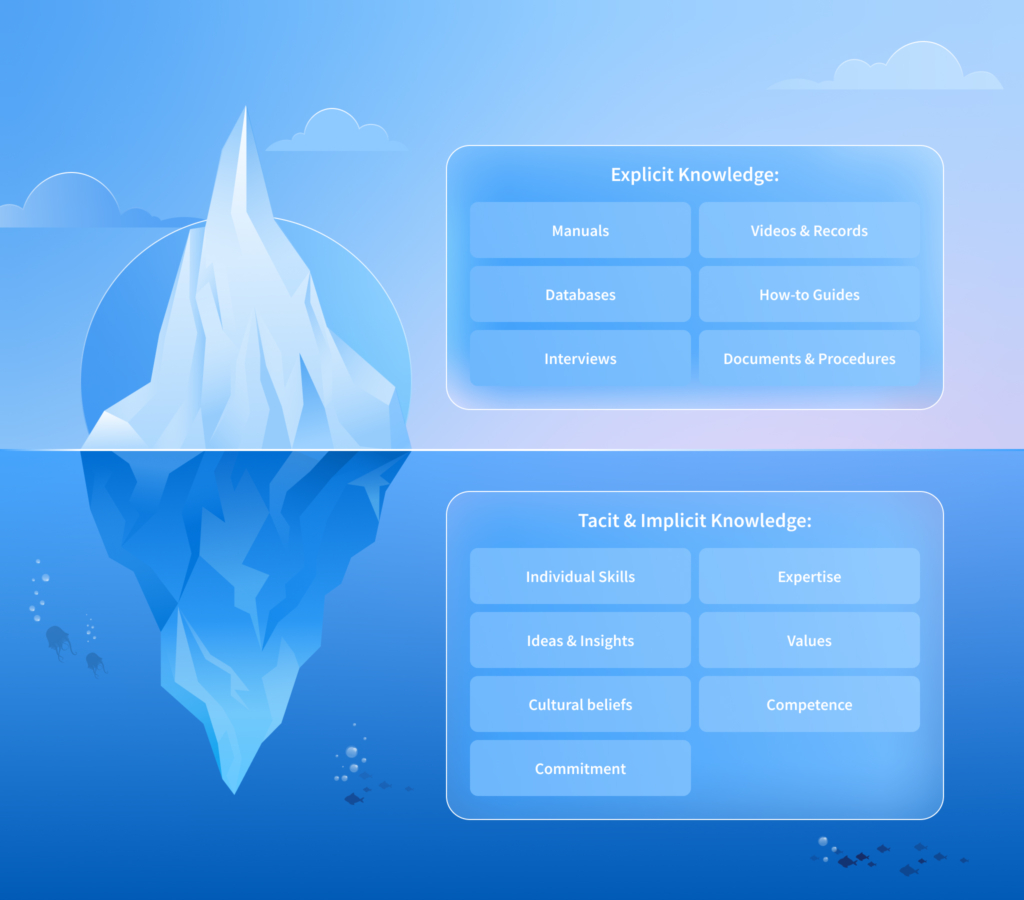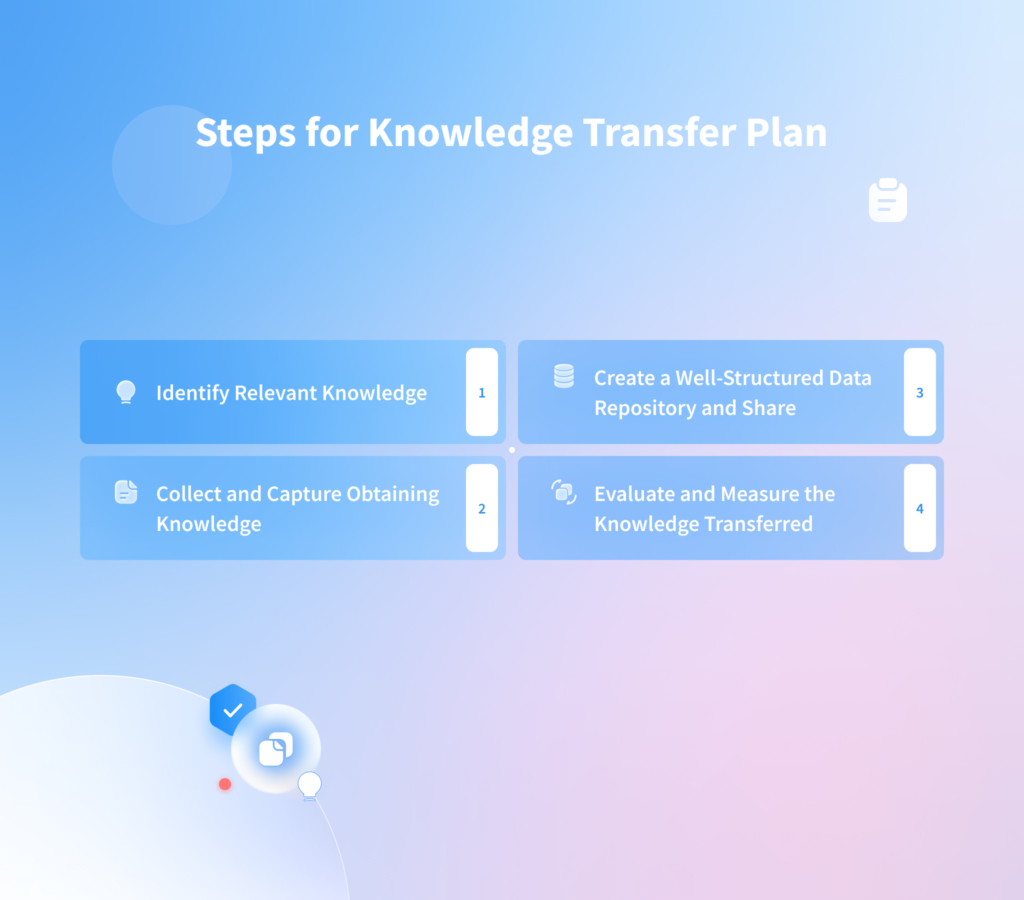

Have you ever thought about what to do next when people who know a critical part of your project or company leave? Or, probably, you have to change your vendors, no matter what they are involved in: mobile app development services, website development services, design services, or QA services.
There’s also the possibility that a team extension is coming, and you must assemble a remote about 57% of companies invest between $500 and $3,000 per employee on the job training. Given the risks associated with staff turnover, companies must look for new ways to reduce this cost item. In particular, in this regard, they are beginning to implement knowledge transfer plans.

These figures are based on reliable data from thousands of employees in businesses that experience knowledge loss daily. In the end, all of these large sums of money are eventually written off under such-and-such circumstances, but in fact, they shouldn’t be, and the transfer of knowledge will prevent the loss of your most valuable resources—time and money. Moreover, it’s an investment in the long-term success of your project. But if this process is not consistent, it’s not what will make you succeed.
Starting with a quick 101: knowledge transfer is a methodical and focused strategy for obtaining critical knowledge from personnel to store and distribute among organizations/employees/vendors for effective process and staff improvement.
“Knowledge is power. Transferring that knowledge is powerful,” says Mark A. Langley, President and CEO of the Project Management Institute.
The top priority for achieving the desired results is to set clear goals for knowledge transfer from the outset. A few questions to consider when setting goals for knowledge transfer:
Of course, these questions are only the first step, followed by planning. So what about the answer to the question, “What is a knowledge transfer plan?” In general, this is a documented strategy for the knowledge transfer, that is, information and processes adopted within a specific organization. If you want to find out how to build it, read below.

It seems to be obvious that the major part of knowledge about a project should be contained in the knowledge transfer document; but in reality, the most vital information needed for the KT plan is often stored in people’s heads. To remedy this, it’s worth using approaches and practices that will change this situation.
“Knowledge is the business! And the best practice of knowledge transfer should accelerate the business value,” says Jean-Claude F. Monney, Global KM Lead, Office of the CTO at Microsoft Enterprise Services.
Speaking of knowledge transfer and building a KT plan, it’s worth mentioning that it’s divided into explicit and implicit and tacit knowledge.

Explicit knowledge is precisely what lends itself to transfer strategies such as formal documents, guidelines, and other described codified processes. They are easier to share and quantifiable. Tacit & implicit knowledge, which can be in the form of, for example, coaching, is harder to pin down because it’s a more intuitive type of knowledge. It’s intangible, ranging from insights learned from personal experience to accumulated experience.
Also, there are different necessary flows associated with building a KT plan involved at various levels:

Knowledge transfer to and from the project and organizational levels is essential in a multi-project environment. Knowledge at these levels depends more on the quality of the data warehouse than on the incentive system.
The most crucial and challenging is to transfer knowledge from the person involved in the project work. This situation is dictated by the fact that sometimes the work is done almost intuitively. Ironically, companies often endorse this behavior as a systematic way to manage knowledge, but it’s rarely well-organized, if at all.
A well-structured data repository is your remedy. The Project Management Office (PMO) should be responsible for creating and maintaining a well-structured data repository in your project. Document things that have not even been done before. This is not limited to text but also the knowledge that must be presented through various means, such as audio or video.
Remember that a knowledge transfer plan is not only about business values and company processes but also tech solutions including tech documents, architecture solutions, descriptions of integrations, etc.
Moreover, people should be encouraged to leave feedback on the quality of the data warehouse in four key areas: accessibility, quality of information, areas covered, and interface ergonomics.
Having become familiar with the issues and understanding the need for an effective knowledge transfer plan, it’s important to find out which areas of your company’s activities will benefit from it.
 Knowledge Transfer Use Cases" width="1024" height="900" />
Knowledge Transfer Use Cases" width="1024" height="900" />
Training. Employees of the organization will be able to rely on the knowledge transfer plan to increase their level of knowledge and improve the skills necessary to perform their work duties. In this way, organizations can launch strategies for the career development of their employees, which ultimately reduces employee turnover rates.

The following are guiding principles of effective knowledge transfer plan:
The NIX team works directly with customer personnel and guides critical stakeholders to understand each of these guidelines and how they can use them to positively impact program success.
We also have experience with other transfers and know all the risks—from vendor to vendor, organization to vendor, and vice versa. We ensure effective knowledge transfer by embedding ourselves in your ecosystem.Our experts are ready to take the hit even if you need knowledge transfer but don’t have any existing documentation or previous staff.
NIX’s expert team will conduct sessions with all groups involved in the knowledge transfer process to identify potential barriers to actual knowledge transfer and find solutions to overcome them as quickly as possible. Some of these in detail are:
Once you have everything you need to set up your knowledge transfer plan, you can begin the step-by-step planning process.

The basis of an effective knowledge transfer plan is to determine what information you need to collect. Not all knowledge is necessary or important—this is essential to understand when planning to collect information. In the majority of cases, project managers identify knowledge that is most important.
If you don’t have a PMO for now, we’ve made a small pool of the core knowledge elements that need to be collected in terms of three different levels:

Individual level. This level is assumed by experts to be the most important in transferring knowledge of IT projects. In the process of the knowledge transfer program creation, everything revolves around the code, and it’s not enough to understand what’s inside the code. One-on-one meetings—both technical and executive as well as online and, better yet, offline training sessions—are a must to understand the logic behind the code and some established best practices when transitioning from one vendor to another.
The NIX team has experienced knowledge transfers of different complexities, thus we can help you identify the most critical knowledge with our team of experts.
Now it’s time to identify the contacts who can provide the necessary information at each level of your knowledge transfer plan. At the organizational level, this could be stakeholders and lawyers; at the project level, managers and technical leads; and on the individual level, meetings between QA-engineers, UX/UI specialists, DevOps, business analysts, etc. It’s important for PMOs to understand critical tasks and also possible pitfalls.
One common guideline is to document all lessons learned at each level. Organizations tend to take several of the right approaches to knowledge retention, as one or two approaches are not enough. What the organization does with that knowledge after it’s collected is equally important and can determine the success or failure of knowledge transfer.
It’s unlikely that nonstop meetings will allow your new development team to absorb all the necessary information. Our experts believe that important knowledge should be recorded in knowledge transfer plans and properly preserved. We use a variety of methods to transfer knowledge, creating a more interactive process for recipients that encourages direct person-to-person knowledge sharing. But some important practices from an average knowledge transfer checklist worth pointing out are:

The next time someone takes on a similar project or set of jobs, they have quick access to past teammate experience as a repository to help optimize the process.
The most effective way to measure the effectiveness of the knowledge transfer process is to check for changes in the competence of the recipient of knowledge— whether it’s a supplier, a customer, or an employee. Undeservedly this stage is considered the final and therefore a minor stage, when in fact this stage in the lifecycle of knowledge transfer is the most difficult but brings the greatest return. At the same time, Linda Argote, Professor of Organizational Behavior and Theory at Carnegie Mellon, claims that knowledge transfer doesn’t happen automatically and knowledge donors and recipients need to be exposed to a transfer opportunity, motivated to transfer, and use appropriate transfer mechanisms where the value of knowledge can be measured.
Indeed, everything can be measured by evaluating the quality of knowledge and analyzing the results in terms of quality, completeness, and efficiency. But it’s worth remembering the starting point to be effective, making an effort to measure the success of the knowledge transfer.
The knowledge transfer processes involve continuous learning, adjusting, and improving. Following the approach described above, success is possible for organizations providing different services, not just software product development services.
If you want to gather knowledge in your project or organization, you cannot do without a solid action plan of knowledge transfer activities and experienced specialists. If you’d like to build a software development team for your project with knowledge transfer, NIX experts will be glad to jump into it. If your business has some gaps in knowledge in existing projects and stalls on improving the product because of this, we can dismantle your product to see how it works, dive deep into processes and chosen tech stack, finding knowledge gaps and offering improvements, as a result.